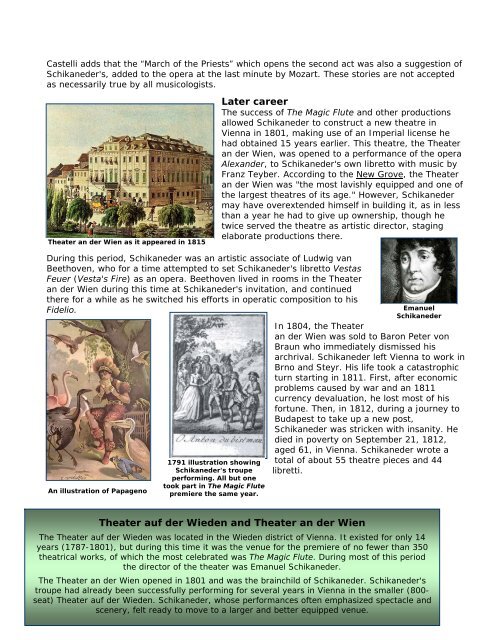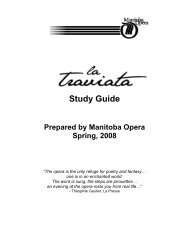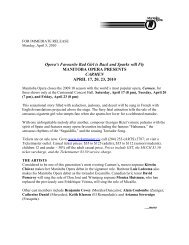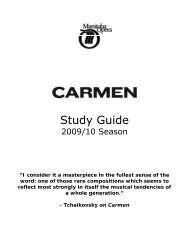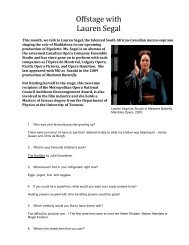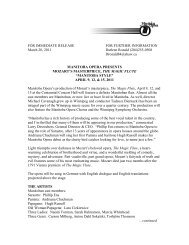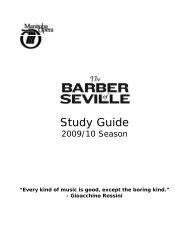The Magic Flute Study Guide - Manitoba Opera
The Magic Flute Study Guide - Manitoba Opera
The Magic Flute Study Guide - Manitoba Opera
You also want an ePaper? Increase the reach of your titles
YUMPU automatically turns print PDFs into web optimized ePapers that Google loves.
Castelli adds that the “March of the Priests” which opens the second act was also a suggestion of<br />
Schikaneder's, added to the opera at the last minute by Mozart. <strong>The</strong>se stories are not accepted<br />
as necessarily true by all musicologists.<br />
<strong>The</strong>ater an der Wien as it appeared in 1815<br />
Later career<br />
<strong>The</strong> success of <strong>The</strong> <strong>Magic</strong> <strong>Flute</strong> and other productions<br />
allowed Schikaneder to construct a new theatre in<br />
Vienna in 1801, making use of an Imperial license he<br />
had obtained 15 years earlier. This theatre, the <strong>The</strong>ater<br />
an der Wien, was opened to a performance of the opera<br />
Alexander, to Schikaneder's own libretto with music by<br />
Franz Teyber. According to the New Grove, the <strong>The</strong>ater<br />
an der Wien was "the most lavishly equipped and one of<br />
the largest theatres of its age." However, Schikaneder<br />
may have overextended himself in building it, as in less<br />
than a year he had to give up ownership, though he<br />
twice served the theatre as artistic director, staging<br />
elaborate productions there.<br />
During this period, Schikaneder was an artistic associate of Ludwig van<br />
Beethoven, who for a time attempted to set Schikaneder's libretto Vestas<br />
Feuer (Vesta's Fire) as an opera. Beethoven lived in rooms in the <strong>The</strong>ater<br />
an der Wien during this time at Schikaneder's invitation, and continued<br />
there for a while as he switched his efforts in operatic composition to his<br />
Fidelio.<br />
An illustration of Papageno<br />
1791 illustration showing<br />
Schikaneder's troupe<br />
performing. All but one<br />
took part in <strong>The</strong> <strong>Magic</strong> <strong>Flute</strong><br />
premiere the same year.<br />
Emanuel<br />
Schikaneder<br />
In 1804, the <strong>The</strong>ater<br />
an der Wien was sold to Baron Peter von<br />
Braun who immediately dismissed his<br />
archrival. Schikaneder left Vienna to work in<br />
Brno and Steyr. His life took a catastrophic<br />
turn starting in 1811. First, after economic<br />
problems caused by war and an 1811<br />
currency devaluation, he lost most of his<br />
fortune. <strong>The</strong>n, in 1812, during a journey to<br />
Budapest to take up a new post,<br />
Schikaneder was stricken with insanity. He<br />
died in poverty on September 21, 1812,<br />
aged 61, in Vienna. Schikaneder wrote a<br />
total of about 55 theatre pieces and 44<br />
libretti.<br />
<strong>The</strong>ater auf der Wieden and <strong>The</strong>ater an der Wien<br />
<strong>The</strong> <strong>The</strong>ater auf der Wieden was located in the Wieden district of Vienna. It existed for only 14<br />
years (1787-1801), but during this time it was the venue for the premiere of no fewer than 350<br />
theatrical works, of which the most celebrated was <strong>The</strong> <strong>Magic</strong> <strong>Flute</strong>. During most of this period<br />
the director of the theater was Emanuel Schikaneder.<br />
<strong>The</strong> <strong>The</strong>ater an der Wien opened in 1801 and was the brainchild of Schikaneder. Schikaneder's<br />
troupe had already been successfully performing for several years in Vienna in the smaller (800seat)<br />
<strong>The</strong>ater auf der Wieden. Schikaneder, whose performances often emphasized spectacle and<br />
scenery, felt ready to move to a larger 19 and better equipped venue.


